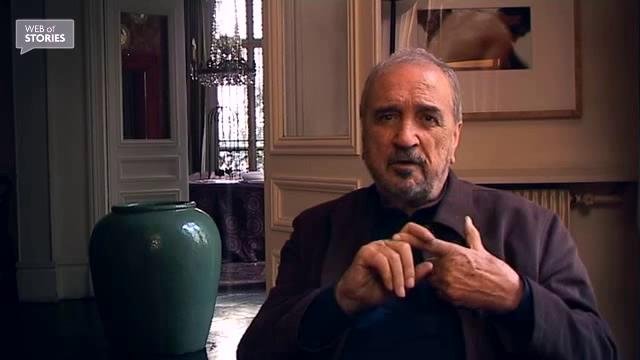NEXT STORY

The 1968 social revolution
RELATED STORIES

NEXT STORY

The 1968 social revolution
RELATED STORIES


|
Views | Duration | |
|---|---|---|---|
| 41. Encountering New York’s hippy culture | 178 | 02:11 | |
| 42. The 1968 social revolution | 146 | 04:00 | |
| 43. Milos Forman | 191 | 02:42 | |
| 44. Paris 1968: the irrational and the unreal | 194 | 02:00 | |
| 45. Meeting Peter Brook | 171 | 02:32 | |
| 46. Working with Peter Brook | 188 | 04:09 | |
| 47. Discovering the 'Mahabharata' | 236 | 04:07 | |
| 48. Visiting India | 183 | 01:12 | |
| 49. What has India brought us? | 221 | 00:33 | |
| 50. In the presence of the Dalaï Lama | 1 | 117 | 02:09 |


En 1968, au début de l’année, je me trouvais au Mexique avec Buñuel, nous travaillions sur la deuxième version, je pense, de La voie lactée. Et on sentait un peu partout les mouvements dans le monde, mais nous, nous étions bien tranquilles dans un très bon hôtel avec des anges et des démons, vivant dans le passé. Et quand je suis à Mexico en mois de… mars ‘68, Milos Forman, que j’avais connu en Italie, m’appelle de New York et me dit: «J’ai un projet de film à New York, est-ce que… ça m’intéresserais de travailler avec toi, nous n’avions jamais travaillé ensemble… est-ce que tu pourrais en rentrant à Paris, t’arrêter à New York?» Je dis: «Oui: pourquoi pas?» Là, nous sommes au début de moi d’avril. Et je prends donc un avion, après une dernière soirée assez folle à Mexico, je me rappelle, je m’arrête à New York et je vais rejoindre Milos à l’hôtel Chelsea, où nous avons vécu par la suite longtemps. Et il me dit: «Voilà, j’ai un projet de film sur le milieu des hippies…» qui commençait, c’était en plein mouvement hippie, moi je ne le connaissais pas très bien. Le soir même, nous étions chez des jeunes gens qui avaient fui leurs familles, ce qu’on appelait dropping out à parler avec eux en essayant de les comprendre car ils employaient un langage argotique en parlant la bouche fermée, c’était assez difficile. Nous sommes restés là plus de trois semaines à New York… à essayer de pénétrer cette nouvelle atmosphère qui se dessinait, quelque chose se passait là.
Mais avril 68, en Amérique, c’est l’assassinat de Martin Luter King, c’est les émeutes à Harlem, ce n’est pas du tout une période réjouissante et gaie malgré l’apparence du pouvoir de la fleur et des dimanches passés dans le Central Park sous un épais nuage de marihuana. Donc après trois semaines nous n’avions pas avancé du tout dans notre projet.
In 1968, at the beginning of the year, I was in Mexico, with Buñuel, and we were working on a second version of The Milky Way. We knew something about some movements throughout the world, but we were well away from it all, in a nice hotel, with angels and demons, living in the past. And in March '68, while I'm in Mexico, Milos Forman, whom I had met in Italy, calls me from New York and says, 'I have a film project in New York, would you… I'm interested in working with you' – we had never worked together before – 'would you stop by New York when you're on your way back to Paris?' So I said, 'Yes, why not?' And there we are in early April. So I take a plane, after a last crazy evening in Mexico, I remember, I stop by New York and go to the Chelsea Hotel to meet up with Milos, where we stayed for a long time. And he says, 'I have a project about the hippy movement...' It was just starting, we were at the core of it, I didn't know it very well… we spent that very same evening with some young people who had run away from their families – people called it dropping out – talking to them and trying to understand them... because they were using slang, talking with their mouths closed, that was quite difficult. So we stayed there for over two weeks in New York, trying to understand and get into that new movement that was taking shape, something was happening over there. April '68, Martin Luther King gets shot, there are riots in Harlem, it's not at all a happy time in spite of the appearance of flower power and all the Sundays spent in Central Park under a heavy cloud of marijuana. So after three weeks we hadn't done anything on our project.
French screenwriter Jean-Claude Carrière (1931-2021) began his association with films aged 24 when he was selected by Jacques Tati to write for him. This early experience led to further contact with other film-makers, including Luis Buñuel with whom Carrière collaborated for many years. He wrote screenplays for films including Belle de Jour, The Discreet Charms of the Bourgeoisie, Tin Drum and Danton.
Title: Encountering New York’s hippy culture
Listeners: Andrzej Wolski
Film director and documentary maker, Andrzej Wolski has made around 40 films since 1982 for French television, the BBC, TVP and other TV networks. He specializes in portraits and in historical films. Films that he has directed or written the screenplay for include Kultura, which he co-directed with Agnieszka Holland, and KOR which presents the history of the Worker’s Defence Committee as told by its members. Andrzej Wolski has received many awards for his work, including the UNESCO Grand Prix at the Festival du Film d’Art.
Tags: New York, Harlem riots, Martin Luther King assassination, The Milky Way, April 1968, Luis Buñuel, Milos Forman
Duration: 2 minutes, 11 seconds
Date story recorded: January 2010
Date story went live: 27 July 2010